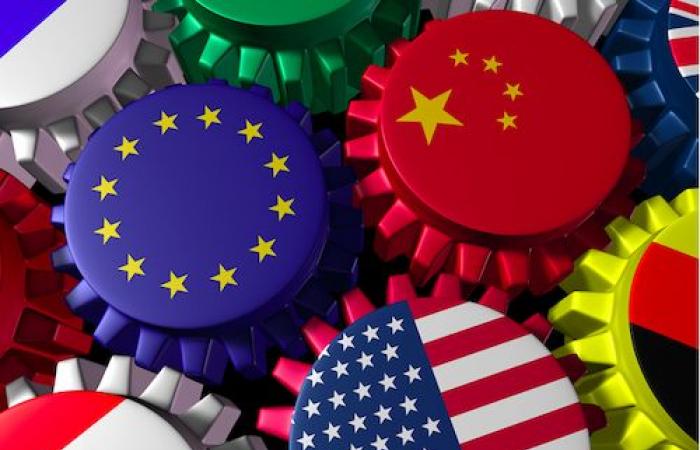October 16, 2024
Based on global flows of exports, imports and foreign direct investments (FDI), we observe a temporal discontinuity in globalization reduced to these three elements over the period 1990-2022. Periodization divides three phases[1]. A first phase of accelerated globalization, sometimes described as hyperglobalization, characterizes the period 1990-2008. The financial crisis (2008-2011) stabilized the variables on a plateau and continued with a decline for the years 2011-2022. The interconnections analyzed take the form of a cycle, they are intended to reproduce themselves, not identically, but reorganized to respond to the multiple fractures which arise in the global space.
The phase of unbridled globalization
This phase experiences an accelerating surge which expresses both the speed of movement of goods, services and productive and financial assets and the absence of resistance to these movements. And this, under the influence of technological advances (ICT, digitalization) which make it possible to divide companies, goods and services into a certain number of tasks, to reorganize them and to relocate some of them[2]. Also driving the institutional contexts (EU, Alena, Trans-Pacific Partnership Agreement) and the diffusion of an ideology centered on companies and markets and on the adoption of commercial policies conforming to the global rules of commercial flows and investments decreed by the WTO. The global exchange system is based on a neoliberal logic of globalization[3].
Between 1990 and 2008, the annual growth of world exports (10%) exceeds that of world GDP (6%), the elasticity between these two variables is greater than unity. In many countries and regions, there is a strong correlation between mutually supportive trade flows and growth (US, EU, China). Structural transformations are at work, the share of global industry in global added value declines from 21% in 1990 to 16% in 2011, the deindustrialization of the countries of the North prevailing over the rapid industrialization of the countries of the South, which produce more but cheaper. Dev Patel, Justin Sandefur and Arvind Subramanian attribute the convergence between the North and the South to three distinct and related phenomena: “faster growth in poorer countries; less volatility in national economic growth rates, suggesting that poor nations become less vulnerable to economic shocks; and particularly strong and steady growth in middle-income countries, disproving the assumption that these countries would struggle to grow once they crossed a certain per capita income threshold[4] ».
A very relative deglobalization
The post-financial crisis period sharply slowed down income convergence and, as a result, increased inequality and increased competition by creating strong pressures for deglobalization, which heavily indebted low-income countries were unable to exploit. their comparative advantages and integrate global value chains, due to lack of financing, and have sometimes been forced to suspend debt service[5]. Moreover, the increasing complexity of global value chains has lowered the returns to coordination because it becomes more difficult for firms to control the entire production process. Finally, globalization is changing in nature: flows and exchanges are influenced by geopolitical considerations as much as by strictly economic reasons.
Generally speaking, the slowdown in world trade from 2011 accompanied the slowdown in global growth. Analyzing this period requires dissociating goods and services. Manufacturing trade fell from 15.6% of world GDP in 2011 to 14.5% in 2021 while trade in services, driven by the digital wave, increased from 6% of world GDP in 2011 to 8% in 2021. More precisely, since 2018, when global GDP increases by 1%, global trade in goods only increases by 0.6%. The causality is twofold: global GDP depresses when trade weakens and trade slows when global growth becomes weaker. In addition, the stricter control of technology exports (semiconductors in particular) and foreign investment, combined with the sharp increase in the number of obstacles to global trade (the IMF lists 2,600 in 2022), has affected trade and FDI flows. Conversely, service supply chains and the trade of intangibles (know-how, data, patents and licenses) are developing increasing links because the digital revolution strongly influences the definition and production of infrastructures, products and services. services. As a result, these links only concern countries with high qualifications and skills.
Interconnections are changing. The imposition of multiple barriers by the United States and China on their bilateral trade has increased uncertainties and pushed companies to diversify their sources of supply and locations. In China, foreign direct investment declined over the period 2014-2020, then collapsed during the pandemic (2020-2022), falling from $400 billion to $15 billion, while it increased sharply towards other regions. : Latin America, Africa, South-East Asia and India. The significant decline in Chinese imports to the United States has resulted in a partial relocation of certain activities and increased imports from Mexico (15% of imports in 2023 compared to 13.9% for China), Vietnam, etc.
Note that trade in goods has marked effects on industrial structures because it creates relative irreversibilities. Despite the blockage of Chinese imports to the United States over the last period, David Autor, David Dorn and Gordon Hanson were able to highlight a delayed effect which would explain the 55% drop in American industrial employment overall. of the period considered. This phenomenon must be analyzed at the local and regional level because the contraction in employment is increasing with the disappearance of companies exposed to competition from China.[6]. Additionally, surveys by Ashish Arora, Sharon Belenzon, and Andrea Patacconi of large U.S. companies exposed to strong growth in Chinese imports indicate a shift in their research spending away from basic research and toward more research. more applied and short-term innovations aimed at conquering markets[7].
The economic and geopolitical weight of China
In a phase of hyperglobalization, trade and foreign direct investment flows reflect the push of the neoliberal model, and the economic and geopolitical power of the United States. Deglobalization is rather configured by the growing influence of China, with this apparent paradox: the Chinese economy is less and less dependent on foreign trade (the foreign trade/GDP ratio declines from 71% in 2008 to 35% in 2022 ), but its place in global trade is increasingly central: the global market share of Chinese manufacturing exports increases from 12% in 2008 to 22% in 2022.
The first indicator of this “Chinese puzzle” reflects China’s refocusing on its internal market and the change in direction of economic policy now favoring non-tradable goods, notably real estate and infrastructure. Public spending orchestrates this change in the composition of production which has the effect of attenuating the competitiveness of the tradable sector by causing an increase in wages on the labor market through the Balassa-Samuelson effect. The second indicator indicates that, despite weakening competitiveness, the productivity differential favoring China in tradable goods is high, so that exports continue to grow[8]. Without denying the role of aggressive mercantilism linked to reduced rate financing practiced by state banks and massive export subsidies, it must also be recognized that the sharply increasing expenditure on R&D has greatly increased technological innovations which in turn fueled productivity gains. In the electric car sector, mastery of technologies throughout the production cycle, from raw materials to the final product, has played an essential role. At the same time and with other Asian countries, China developed the Regional Comprehensive Economic Partnership Agreement which brings together 15 countries representing a third of global GDP and which now represents the most extensive free trade agreement in the world. world.
Relocations and reconfigurations
As we can see, the image of deglobalization distorts what has been happening for several years. Interconnections shift over time with other partners, for the simple reason that in most economies sovereignty is unattainable in all sectors. Trade remains, a dynamic of continued specialization, but States play an increasing role in defining specializations. In this context, they replace markets: industrial policy aims to strengthen significant anchor positions in markets of strategic economic and geopolitical importance and forms of protectionism are developing. Even the European Commission is now proposing to strengthen the screening of industrial investments and sensitive sectors (semiconductors, AI, medicines), the regulation of platforms concerning digital services and digital markets, as well as the control of the export of goods for dual use, civil and military. This dynamic has been observed since the 2010s, but a decisive impetus is given by the two laws passed in 2022 in the United States, the CHIPS and Science Act ($88 billion) which aims to restore technological leadership to this country in the high-end semiconductor segments, and the Inflation Reduction Act, whose $400 billion is intended to develop green technologies and renewable energies, modernize transportation and increase energy savings.
In this context, exchanges continue and sometimes develop, but they are reconfigured. The cycle of globalization is not over. It is entering a new phase marked by the development of public forms of economic management.
Did you enjoy this article?
Support Telos by making a donation
(and benefit from a 66% tax reduction)
Please enter a description
Please enter an amount
Please enter an Invoice ID
[1] A. Subramanian, M. Kessler et E. Properzi, «Trade hyperglobalization is dead: Long live…? », Peterson Institute, 2023.
[2] B. Guilhon, The Paradoxes of the knowledge economyHermès Lavoisier, 2012.
[3] L.Tyson, J. Zysman et B. Judge, « The New Logic of Globalization: Uncertainty, Volatility, and the Digital Economy», BRIE Working Paper, 2023-4.
[4] D. Patel, J. Sandefur et A. Subramanian, « A Requiem for Hyperglobalisation: Why the World will Miss History’s Greatest Economic Miracle», Foreign AffairsJune 2024.
[5] A. O. Krueger, A world of debt », Project SyndicateMay 2023.
[6] D. Autor, D. Dorn et G. Hanson, « On the Persistence of the China Shock », NBER, 2023.
[7] A. Arora, S. Belenzon et A. Patacconi, « Killing the Golden Goose? The decline of science in corporate R&D », NBER Working Paper Series, janvier 2015.
[8] A. Subramanian, «The Paradox of China’s Globalization », in The Chinese Capacity Puzzle, Project SyndicateAugust 2024.






